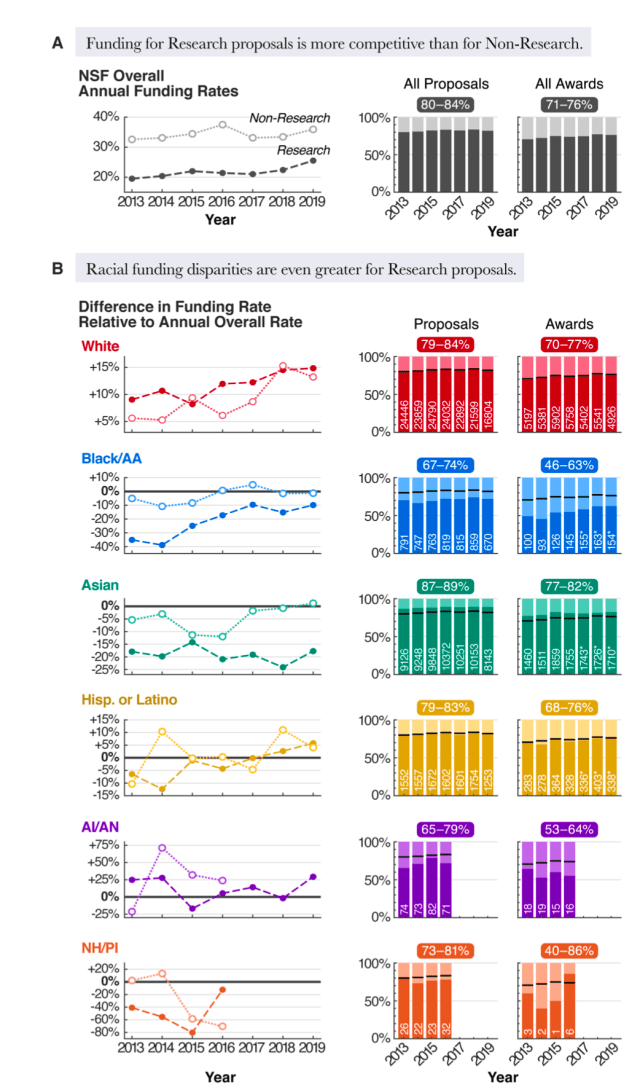Systemic racial disparities in NSF funding
If you’re doing basic scientific research in the US, here’s a new must read. This preprint by Chen et al. dropped on Friday, entitled “Decades of systemic racial disparities in funding rates at the National Science Foundation.”
Using over 20 years of data on funding rates, they demonstrate that white PIs have been getting funded at higher rates than non-white PIs. It feels like the scope of this preprint is similar to what Ginther et al. documented for NIH in 2011. Since that time, the Ginther Gap has been central to discussions involving disparities at NIH.
I think the figures speak for themselves, so I’m going to just share some of them:
Figure 1 shows that white folks have consistently been getting more funding across the years.
Figure 5 shows how ad-hoc review scores are particularly lower for black scientists:
Figure 3 shows that funding rates in general are lower for research awards compared to non-research awards, and that the disparities in these research awards are greater:
This should come as zero surprise to us. It should be expected. Not because of anything notably different about NSF, but simply because it’s an institution here and racism is baked into (perhaps) everything. I think Dr. Dzirasa says this well:
The prior should clearly be that systemic racism is woven into our legacy institutions until proven otherwise. Can we finally just reverse the burden of proof???? https://t.co/iM331w9qWh
— Kafui Dzirasa, MD PhD (@KafuiDzirasa) July 24, 2022
One thing raised in the discussion is that disaggregated data are needed to understand the nature of this challenge and to design appropriate interventions. For example, how does this intersect with gender? (Also, those of us in Small Ponds are presumably also interested with how this breaks down by institution type. I can hypothesize that the disparities would be greater in non-R1s, but I can also hypothesize just as credibly that they would be smaller. Or perhaps there’s no difference. If you’re targeting interventions, this is stuff is needed to ensure that resources are well targeted.)
There are a lot of straightforward interventions that are suggested in the discussion of the paper. One of the bigger suggested lifts is to update our perspective on the myth of meritocracy. As Chen et al. explain, “The use of merit review criteria to find and fund ‘the best ideas and the best people’ is motivated by a shared understanding that the integrity of research knowledge relies on individual and collective adherence to principles of objectivity, honesty, and fairness. However, a vast body of research shows that systems designed to facilitate impartiality and merit-based rewarding can instead perpetuate the very biases they seek to prevent.”
One thing to keep in mind that this is a preprint, and it’s not clear how additional peer review might result in revisions. However this manuscript is clearly getting lots of peer review. However, so far it has a lot more “likes” on twitter than downloads from the website. So it’s getting a lot of conversation, but not we still need a lot of us to dig in.
Drugmonkey has posted a more detailed take on Chen et al. Considering his substantial experience with the impact (or the lack thereof) of the Ginther report over at NIH, then he’s well qualified to interpret what’s going on over at NSF. I’ll leave you with his bottom line: “Go read it. Study. Think about it.“





